#mythic salamander
Text
sold
#pottery#ceramics#ceramic#ceramic art#underglaze painting#video#pottery painting#fire salamander#salamander#salamander art#mythical creature#fantasy art#claypigeon#glazeware
1K notes
·
View notes
Text

Passed by a wall with a salamander king on it. Thought you guys might enjoy him.
#196#photography#dragons#dragon#mythical creatures#lizard#salamander#drake#fantasy#gargoyles#architecture#fantasy creatures#crown#nyc#new your city#new york#manhattan
40 notes
·
View notes
Text
Paracelsus' Four Elemental Spirits
Now, you may have heard of Paracelsus or his four elemental spirits, but have you read the book they featured in? If not, here's some notes:
A Book on Nymphs, Sylphs, Pygmies, and Salamanders, and on the Other Spirits by Theophrastus von Hohenheim (Paracelsus) (1566)
Spirits:
-In Paracelsus' reckoning, human beings possess nature (in the body), spirit, and an angel [internal holiness? or like a literal guardian angel/personal genius?], present in the soul
-Supernatural beings, called spirits or elementals, have neither a soul nor an angel, but only a body, like animals
-And yet, he continually compares both their form and mannerisms to true spirits
-Later says most people see them as spirits, or mirages, but he claims they are flesh and blood
-Unlike true spirits [angels and demons, probably] they cannot move through all matter. They are flesh and blood, and must walk, eat, drink, and reproduce
-When they die, they die without a soul, only returning their body to nature
-Have no compulsion to serve God
-Each type of elemental lives in its own abode, which humans can interact with
-None of the elementals intermingle with each other [no inter-breeding]
-[Shows a few interesting bits of folklore, but is bogged down by Paracelsus' own weird world-building and semi-science]
Undine:
-Frequently called nymphs
-Spirits of the water. Reside in brooks and rivers
-Eat from the mud, where earth and water mix
-Look exceedingly similar to human beings [he says both men and women, but read below]
-Grasp people that swim near them
-Seek to woo and marry men to attain an eternal soul
-Venus was a historical undine that ruled in a Venusberg (see below)
-She gathered many kingdoms together, but they fell apart during her death, as none of her successors were as well-endowed as her
Gnome:
-Also called the mountain people
-Spirits of the earth. Reside in earth as easily as we reside in air, moving through stone without issue
-Because they live in a coarse material, they are made of subtle material to pass through it
-Their food grows in water rather than in soil [get nourishment from the materials in aquifers? or underground lakes?]
-Very small in appearance, only two spans tall [if we assume an English span, that would be 18 inches]
-Never marry with humans, though may serve them
-Have supernatural knowledge of the future and past
-Guard the treasures of earth (jewels and precious minerals)
Sylph:
-Also called the forest people
-Spirits of the air. Closest to humans, who also live in air and suffocate in water and earth, and burn in fire
-Eat wild plants and herbs, nourished by rain from the heavens and the soil of earth
-Cruder, coarser, longer, and stronger than human beings
-Shy and quiet
Salamander:
-Spirits of the fire
-Fed by the earth and air
-Long, narrow, and lean in shape
-Can be heard yelling and hammering in volcanic regions
-Never marry humans, and rarely serve them
-Have supernatural knowledge of the future and past
-May appear as fiery lights in far distances or passing through homes
-Commonly work with witches
-Guardians of precious materials, a job they share with gnomes
-Will-o'-the-wisps are the monsters of the fire people, like sirens below
Siren:
-Relatives of nymphs, or a sub-set of them
-Live on the water rather than in it [like on islands?]
-Monstrous in appearance
-Born from undine parents, but are considered wicked and strange
-Do not marry and bear human children
-So few male sirens are born that the women form Venusbergs; large collections of nymphs/sirens
Giant:
-Monsters born from the forest people, like sirens
-When giants come together it is like a thunderstorm or earthquake
-Not impressed by the constellations of Heaven
-Infertile. Because of this, they've died out
Dwarf:
-Monsters born from the mountain people, like sirens
-Greater and stronger than human beings, despite being shorter than them
-Infertile. Because of this, they've died out
#myth stuff#mythical creature#mythical creatures#folklore#spirits#elemental#elementals#paracelsus#undine#gnome#sylph#salamander
15 notes
·
View notes
Text
has any human ever actually seen a salamander irl btw
#they're like a cryptid to me#i've known about them since early childhood. i've known what they look like and that they live in the mountains.#i honestly really really wanted to see one as a kid#and i've been in the mountains so many times. hiking on non-touristy trails that should be okay for seeing wildlife. i've spent so much-#-time in the mountain woods and canyons and rivers and quarries#and never did it feel like a place where you could realistically see that thing#i know all the theory. i studied fucking zoology. i know it's just a normal ass amphibian#but for some reason i just. can't imagine seeing it? can't imagine it existing somewhere and just walking around like that in the woods#it feels like a mythical thing#hell it feels like i'm being gaslit by everyone saying they're common in the mountains#how is that thing common. how is that thing even there#my brain riots when i try to imagine a salander just being irl#y. you feel me#i don't know how to explain it they just feel like a fictional thing that you can't actually meet or see or touch#ramble#hello welcome to my Salamander Thing that i've never actually told anyone about lol#i have zoology autism 😔#so i read everything i could on the topic since i could read and out of all the animals i learned about these fucking things just always-#-stuck out#like i'm reading a 'polish fauna' book and everything's normal and as expected then suddenly there's a bright yellow-black lizard there-#-that doesnt fit in with anything that lives here. what do you mean this thing exists HERE and youre telling me its common#where. where is it.
8 notes
·
View notes
Text

salamander steed
#my art#art#artists on tumblr#traditional art#fantasy art#fantasy illustration#illustration#salamander#salamander art#fantasy steed#fantasy#mythical creatures#poncy lil hat
6 notes
·
View notes
Photo
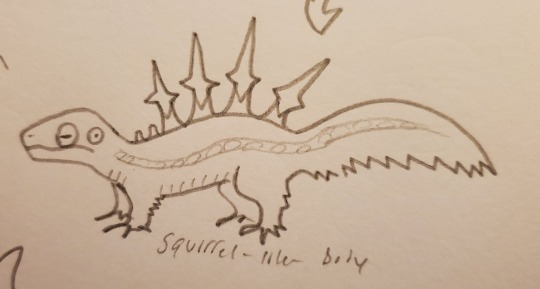
An experiment with the design of the mythical salamander, trying to mix the reptilian and non-reptilian characteristics by using a squirrel as a base. The rest of the traits are a mix from this post of various depictions of salamanders. The head is reptilian, but it has odd external ears. The body is covered in a mix of scales and "hair", which is actually dried poison forming into asbestos-like crystals. The back spines are a combination of the line of stars usually running down the body, the wings in more abstract depictions, and my own use of Longisquama from the past.
#myth stuff#salamander#mythical salamander#fire salamander#mythical creatures#mythical creature#monster
4 notes
·
View notes
Text
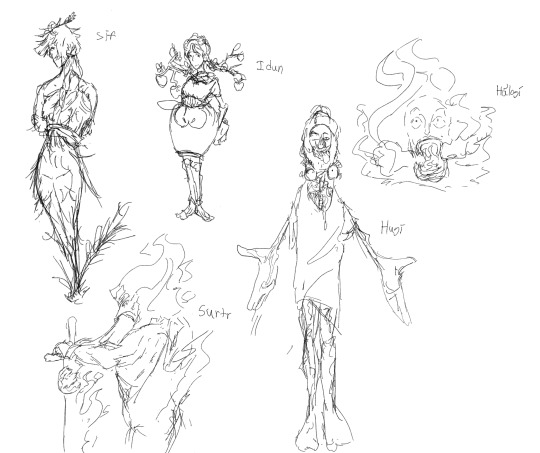
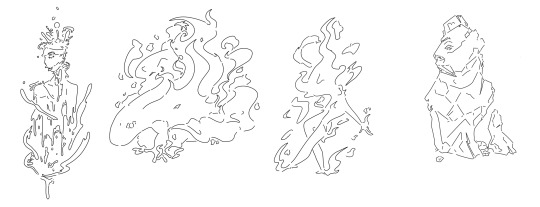
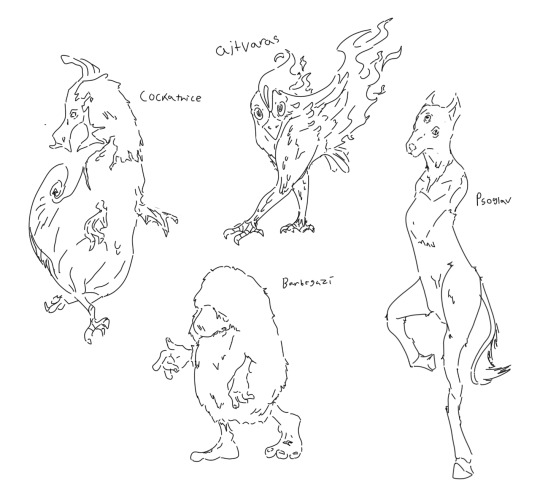
Recent mythological creatures and deities designs sketches.
#European#europe#folklore#mythical creatures#mythologyart#norse mythology#mythology#european mythology#salamander#a#my art#my art shit#oc art#oc
5 notes
·
View notes
Text

Charmander will always be one of the best starter Pokémon!
🔥🦎
#history#charmander#salamander#pokemon#mythology#ancient greece#alchemy#nintendo#starter pokemon#mythical creatures#medieval europe#medieval history#video games#animals#game freak#kanto#folklore#pokemon origins#video game history#european folklore#myth#age of discovery#animal history#ancient greek history#ancient greek mythology#fire#nickys facts
1 note
·
View note
Note
Something I was thinking about last night: where does one draw the line between "misunderstandings about actual animals" and "this is a new mythical creature / cryptid"? Is it even POSSIBLE to draw such a line? Does it depend if someone's looking for a Beast for their fantasy novel/game, and if it's sufficiently distant in time or space or culture?
Like, that bestiary description of a panther. It has ZERO connection to any features of a panther, but we think of it as "they were really wrong about panthers", and not "they were describing a creature which doesn't actually exist".
Yeah it's arguable. I also think "cryptid" has been overused to the point that it's completely meaningless. Garden gnomes are cryptids. UFOs are cryptids. The ghost of Anne Boleyn is a cryptid.
Personally I would consider that things like panthers and dragons and unicorns are complicated because there are some that are honest attempts to describe an animal that someone somewhere saw, some are attempts to make a moral allegory somewhere, and some are honest to goodness errors. People used to believe that snakes run away from naked people, beetles inflate cows, and that salamanders extinguish fires. Does that make them cryptids?
I like thinking of "cryptids" as what happens when both biology and folklore/ethnology/classical studies are thrown out the window.
208 notes
·
View notes
Note
I have no idea what Arkknights is
And at this point im afraid to ask
Girls be called shit like Asbestos, Gravel, Mud and Debris
They eat rocks???
Gatorpeople???
Working in difficult terrain? I dunno
But i know the lesbians go crazy over it
I can clarify this (well, clarify again, I get this question occasionally).
Arknights people aren’t actually named asbestos, gravel, mudrock, cement, rockrock or any of that other stuff. Those are operator code names. A lot of the characters we don’t know their actual names, and since they go by their code names in the game anyway that’s just how people refer to them. All of them choose their code names (except arguably Pudding) so they frequently choose things significant or symbolic of who they are. Asbestos is a fireproof salamander who is a toxic jerk and has cancer so it was a very fitting name. Cement is a construction worker. Rockrock’s name is Rochelle Rockwell. There’s a lot of different reasons but ultimately those aren’t their actual names, but they are effectively their names.
They don’t actually eat rocks. As a gameplay mechanic, characters require resources in order to be promoted and become more powerful in game. However the resources they require for upgrades are kind of strange things like weird metals, cubes of rock, devices, a non alcoholic chemical that apparently gets you effectively drunk if you ingest it, and a bunch of other stuff. Tomimi, the alligator girl who is known for having an extremely fat tail despite her being a fairly short and small person, requires concentrated orirocks that require well over 100 orirock cubes to craft in order for her promotion. So I make dumb jokes that she was eating the cubes and that’s why her tail is fat
Gatorpeople? Yep! Almost all the characters in Arknights are like the type of catgirls that are human but have cat ears and a tail, but for a bunch of different types of animals. There are a few that are anthropomorphic animals and then there’s the people who are demons, vampires, elves (very rare. There’s only one), and characters based on mythical creatures like manticores, nues, all kinds of dragons, etc. there’s also some robots, not robot girls, just robots, they’re mostly rectangular and on wheels. And then there’s weird crossover characters like a stack of the cats from monster hunter, but those aren’t really canon anyway.
I don’t actually know what you’re specifically referencing by the difficult terrain thing but the world of Arknights is full of large scale catastrophes that require most cities to be on enormous moving platforms so they can avoid catastrophes. The world is also full of many hazards. I don’t know what else you might mean so I can’t help more with that
Yes the lesbians go crazy for it. ~80% of the characters are women who are often written to be competent and powerful and actually the focus of the stories. A lot of them are at implied ranging from slight hints to extremely blunt and obvious by their behavior to be lesbians. The story and setting are interesting, the characters have cool designs and interesting personalities and narratives, and a lot of them are gay women, and especially with the kenomimi-style animal girls, it’s not particularly surprising that other people like me get so obsessed with them.
Funnily enough, I think there’s still only 2 “canonical” lesbian operators if you take the extremely blunt stance of ignoring everything that doesn’t outright explicitly involve them professing their love or being in an explicit relationship with a woman. But you’d have to be intentionally obtuse to actually think those are the only ones given how a lot of the women act
#this was longer than I intended it to be#It is true to my core that for better or worse I am unnecessarily verbose#usually because I’m afraid people will misinterpret my meaning and usually in uncharitable ways if I don’t use the extra words to clarify#arknights
70 notes
·
View notes
Text
Inhale (killk me)
kinito pet au ideas (all mine now)
Pirate au, swap/opposite au, frenzy au, beach vally au, valentines au, broken computer virus (BCV) au, house care au, real virus au, mimic au, best friend au, candyland au, light's out au, time traveler au, steam punk au, ghost au, phasmophobia au, dragon barrier au, librarian au, magical forest au, fruit au, fruit au, furry au, sailor moon au, pride au, obsessed au, ice cream au, midnight starlight au, AHIT au, star collector au, broken heart au, rejected friend au, accepted friend au, Poppy Playtime au, Five Nights At Freddys au, Warrior cats au, Midnight driver, killer au, prince of the night au, pool swimmer, Magical boy au, Critical au, Escape room au, god au, AU god au, Au hunter AU, scream au, Mii au, plane crash au, pilot au, mc donalds worker au, driver au, smile tapes au, nightmare au, night gamer au, artist au, over eater au, roblox au, creator au, caseoh au, wii au, wand au, childhood friend au, possessed au, apple core au, string worm au, drunkie au, caretaker au, love maniac au, drier au, washing machine au, Im a pretty princess au, venting au, among us au, gentle man au, Youtuber au, Actual axolotl au, you are what you eat au, mince meat butcher au, butcher au, doxxed au, sally the witch au, autistic au, ADHD au, Autistic and ADHD au, Motherborn au, alien au, Mother Mother au, soul au, dragon born au, vampire au, vampire hunter au, it was all just a dream? au, sunshine au, digital circus au, clockwork au, gymnastics au, rainbow factory au, twisted and turned au, patchworks au, unseen au, joker au, minimum wage worker au, skinwalker au, kinito darling au, forever and ever, everlasting pain, story teller au, time teller au, zoo keeper au, smiling critter au, truth be told au, rizzler au, farmer au, anthro au, Digital pop up au, backfired au, chef au, cuphead au, BABQFTIM au, carnival au, internet explorer au, kidnapper au, robber au, parental figure au, parent au, father au, apple picker au, trans au, siren au, mermaid au, cloud critters, monster energy au, emo au, goth au, alt goth, prince au, princess au, priest au, reality au, Epic the musical au, bass voice au, prince of the sea au, stranger au, never used au, stranger things au, abandoned au, hazbin hotel au, lemon and lime au, softie au, grunge au, sugar crush au, rainbow friends au, block break friends au, sugar crush au, sweet tooth au, undertale au, heartless au, toxic au, waist au, epic au, error au, fresh au, reaper au, horror au, other sans aus, medical au, high school au, ruby and max au, little horrors au, planter au, plant au, crystal au, glass crystal au, rockstar au, ancient Greek au, mario au, shroomba au, sonic the hedgehog au, snowday au, cave monster au, dinosaur au, game show hoster au, lunar moon au, bloodmoon au, eclipse au, sundrop au, moondrop au, dignity au, angels gaurd au, demons gaurd au, king of hell, king of the sea au, mother nature au, king of the land, landlord au, your boyfriend au, planetary au, leopard gecko au, leopard au, train conductor au, mountain lion au, polar bear au, Mad Scientist au, don't die au, raindrops au, seraph au, always watching au, teacher au, birthday party au, husk au, royal au, gummy bear au, cannibal au, discord au, My little pony au, bumblebee au, cat au, animal au, sweet treat au, warzone au, warframe au, roblox au, unicorn au, factory worker au, you au, dihedra au, pee au, every au I forget, Deleted forever au (not really), sleep tight au, Fire borne, dragon au, mythical animals au, goodbye friend, rise of the teenage mutant ninja turtles au, Replicate au, smartie pants au, femboy au, backrooms au, gurlie au, too silly au, silly au, TADC au, lovesick au, grand master au, crazy au, lab monster au, (insert every animal here) au, Monster under your bed au, sloozy au, nightmare monster au, aroace king au, your imagination au, salamander au, desktop pet au, ukagaka au, he knows what you are au, roller blades au, you can run but you can't hide au, poison rain au, dementia au, mr worldwide mr 305 au, anime au, welcome home au, Yume Nikki au, gacha life au, gacha club au, Battle blocks au,
#kinitopet#kinito my beloved#kinito pet au#kinito pet#kinito#etc#kinito au#please don't steal#im watching you fools#yer fools
62 notes
·
View notes
Text
Demi god au.
Pretty much the d clan are Demi gods.
Garp is the offspring of justice, Dragon is mothered by the God of storms. Luffy was born to the sun, Roger with the sea. Rouge was born to the God of the Afterlife.
Ace was just born to two Demi gods.
Demi gods and 1/4 gods all are covered in glyphs. All of them have a circle of their back with a mark to represent their god. Luffy has a sun with a detached inverted spike ring on the outside. Ace has two smaller ones.
They get some form of magic, luffy gets fire, Roger get water manipulation, Garp got disowned and doesn't have magic anymore.
Ace just gets weak ghost sensing and the ability to breath under water.
The glyphs also have an animal type design/familiar to go with it. Luffy has a lion dog on his shoulder and one as a familler. Roger had a sea king on his lower back. Garp lost his tiger, but it was on his upper back. Rouge had a kitsuine on her thigh. Ace gets a salamander on his bicep, Dragon has a western dragon on his lower arm.
The summones are gaint mythical animals, Ace's salamander can grow as large as Whitebeard and light on fire, Luffy's lion dog can get a big as the thousand sunny. Dragon's dragon can get as big as Kaido.
#demi god au#one piece#monkey d luffy#portgas d. ace#monkey d dragon#monkey d garp#gol d roger#portgas d rouge#Garp was disowned when he joined the marines#the tiger still looks over him but he can't be summoned
61 notes
·
View notes
Text
Me in middle school: I'm gonna design an alphabet... For my shapeshifting four-armed aliens that live inside a sphere of ice and water!!!
Me later: Welp, this isn't seeing much use. I'm just gonna use it for generic magic runes/secret messages in my art.
Me in freshman year: Hehe i made up this fantasy race based on olm salamanders. And they have six legs, like mythical salamanders! Might as well use my alphabet for them!
Me in college now: Haha what if i made those olmfolk into a sci-fi alien race called Proteans... and these shapeshifting four-armed aliens that live inside a sphere of ice and water use the same alphabet as the olmfolk, i guess...
waitasecond.
#AND YET A TRACE OF THE OLD SELF EXISTS IN THE FALSE SELF#shitpost#proteans#olmfolk#conlang#i have one(1) idea. and its a good one
80 notes
·
View notes
Text

Title: The Elements: Fire
Suggested Reading
*Highly recommended
Correspondences*
Visualization*
Bias in Witchcraft*
Witchcraft Vs. Superstition*
Dualities in Witchcraft*
Basics of Spellcasting*
Sigils: How-To
Threshold Theory*
Foundations of Energy Work
Spirit Work: First Steps
Researching Witchcraft
🔥What is Fire in Witchcraft?🔥
In the realm of esoteric practices and magical traditions, there exists a rich tapestry of beliefs and rituals that have captivated human imagination throughout history. From the art of sigil magic to the intriguing encounters with spiritual entities, practitioners have sought to explore and harness the mystical forces that permeate our world. Let’s delve into the multifaceted aspects of witchcraft, spirit work, and the intriguing phenomena associated with these practices. The concept of correspondences holds a significant place within metaphysics and esoteric practices, offering insights into the interconnectedness between various elements and their symbolic representations.

🔥Correspondences for Fire🔥
Fire, as an elemental force, embodies a rich tapestry of correspondences that span diverse aspects of human experience.
(There are small breaks because the list broke the 4000-odd word block limit)
Direction:
Fire is commonly associated with the direction of the South, representing its transformative and passionate qualities. It symbolizes the energy of the noonday sun, where its radiant heat and fervor are most pronounced. In this direction, fire serves as a guiding light, illuminating paths of self-discovery, motivation, and transformation.
Season:
Fire aligns itself with the season of summer, characterized by warmth, growth, and the flourishing of life. During this season, fire's transformative power manifests through the ripening of fruits, the crackling of bonfires, and the vibrant colors of blooming flowers. Summer becomes a metaphorical representation of the fiery nature within, fueling inspiration and creative expression.
Time of Day:
The element of fire finds affinity with the daytime, particularly with the hours of noon and mid-afternoon. These periods symbolize the zenith of vitality, creativity, and the fervent pursuit of goals and ambitions. Fire's association with daytime underscores its ability to ignite passion, determination, and the courage to take action in pursuit of one's aspirations.
Astrological Signs:
Fire finds representation in the astrological signs of Aries, Leo, and Sagittarius. These signs embody the fiery traits of passion, courage, self-expression, and the pursuit of adventure and truth. Individuals born under these signs often exhibit qualities of leadership, enthusiasm, and an innate ability to inspire and ignite the flame of inspiration in others.
Planets:
The celestial bodies of the Sun and Mars resonate with the essence of fire. The Sun, as the central luminary in our solar system, signifies vitality, illumination, and life force, akin to the fiery nature of the element itself. Mars, on the other hand, symbolizes assertiveness, determination, and dynamic action, embodying the transformative power and intensity of fire.
Tarot:
Within the realm of tarot, fire is associated with the suit of Wands. The Wands represent inspiration, creativity, willpower, and the ability to manifest one's desires through focused intention and action. This suit embodies the fiery spirit of ambition, drive, and the initiation of transformative change in one's life.
Elementals:
Salamanders, the elemental beings of fire, are often regarded as its guardians and representatives. These mythical creatures symbolize the fiery energy and the transformative power inherent in the element. They serve as spiritual allies, guiding individuals towards personal growth, purification, and the cultivation of inner strength.
Colors:
Fire is associated with vibrant and warm colors such as red, orange, and gold. These hues reflect the passionate, energetic, and transformative qualities of fire, evoking feelings of enthusiasm, creativity, and vitality. Through the utilization of these colors, practitioners can enhance their connection with the fiery essence and invoke its power in rituals and visualizations.
Crystals:
Fire-related crystals like carnelian, citrine, and sunstone embody the energetic properties of fire. They are believed to inspire creativity, increase motivation, and activate personal power. These gemstones serve as conduits for the fiery energy, supporting individuals in their transformative journeys and igniting the flame of passion within.
Herbs:
Herbs associated with fire, such as cinnamon, ginger, and cayenne pepper, possess warming, stimulating, and energizing properties. These herbs can be used to invigorate the senses, enhance focus, and amplify one's vitality. They are often employed in rituals, spellwork, and culinary practices to infuse the transformative energy of fire.
Trees:
Trees like oak, pine, and cedar embody the fiery nature through their robustness, resilience, and ability to withstand flames. These trees symbolize strength, endurance, and the power of transformation. They serve as sacred allies, providing support and guidance to individuals seeking to harness the transformative energy of fire.
Animals:
Animals associated with fire, such as lions, phoenixes, and dragons, represent strength, courage, and resilience. They embody the transformative power and the untamed energy of fire. These animal archetypes inspire individuals to embrace their inner fire, overcome challenges, and embark on personal journeys of growth and self-discovery.
Deities:
Deities like Brigid, Pele, and Vulcan/Hephaestus represent the fiery aspects of creation, transformation, and the forging of the divine spark. They embody the transformative power, passion, and creative force inherent in fire. Invoking the presence of these deities can ignite inspiration, creativity, and the will to manifest desired changes.
Mythical Creatures:
Mythical creatures like the phoenix and the salamander symbolize rebirth, transformation, and the ability to rise from the ashes. These creatures embody the fiery energy of renewal and the transformative power of fire. Their symbolism serves as a reminder of the cyclical nature of life and the potential for personal transformation.
Metals:
Metals associated with fire, such as gold and brass, embody its radiant, luminous, and transformative qualities. These metals symbolize wealth, abundance, illumination, and the refinement of the self. They can be utilized in ritualistic practices to amplify the fiery energy and invoke its transformative properties.
Symbols:
Fire-related symbols, such as flames, suns, and triangles, represent the energetic and transformative nature of fire. These symbols serve as visual reminders of the element's power and can be employed in various metaphysical practices to connect with its essence and harness its transformative energy.
Body Parts:
Body parts connected with fire include the heart, representing passion, love, and emotional intensity, and the core muscles, symbolizing strength, vitality, and the energetic center. These body parts reflect the transformative and energetic nature of fire within the human experience.
Senses:
The sense of sight is closely linked to fire, symbolizing clarity, illumination, and the ability to perceive truth and inspiration. The sense of touch also resonates with fire, evoking warmth, energy, and the ability to ignite passion and enthusiasm within oneself and others.
Emotions:
Fire is associated with emotions such as passion, courage, enthusiasm, and inspiration. It embodies the transformative power of intense emotions and the ability to channel them towards creative expression, personal growth, and the pursuit of one's goals and desires.
Personality Traits:
Individuals embodying fire-related personality traits are often described as passionate, assertive, courageous, charismatic, and driven. They possess a zest for life, display leadership qualities, and exhibit a magnetic energy that inspires and motivates others.
Musical Notes and Instruments:
Musical notes like C and musical instruments such as drums and trumpets resonate with the fiery energy. These notes and instruments evoke feelings of passion, energy, and enthusiasm, creating a sonic backdrop that enhances the experience of fire-related rituals, ceremonies, and meditative practices.
Zodiacal Signs:
The zodiacal signs of Aries, Leo, and Sagittarius align with fire, emphasizing their connection to the element's transformative qualities and fiery attributes. These houses embody the themes of individuality, self-expression, creativity, and the pursuit of knowledge and truth.
Incense and Essential Oils:
Fragrances such as frankincense, cinnamon, and ginger, as well as essential oils like bergamot, rosemary, and ylang-ylang, are associated with fire. These scents possess invigorating, energizing, and transformative properties, creating an olfactory ambiance that aligns with the fiery essence.
Tarot Spreads and Major Archana Cards:Fire-related tarot spreads and major archana cards provide insight into various aspects of personal transformation, creative endeavors, and the manifestation of desires. The Major Arcana cards associated with fire in the Tarot are The Fool, The Magician, Strength, The Tower, and The Sun. The "Passion and Creativity Spread" is a Tarot spread designed to delve into the realm of personal passions and creative expression. This spread consists of five cards arranged in a specific pattern to provide insights and guidance regarding one's creative endeavors and the fire within. Here is a description of each position in the spread:
Spark- This card represents the initial spark of inspiration or passion that ignites your creative energy. It sheds light on the core desire or idea that fuels your creativity.
Fuel- The second card reflects the elements or resources that serve as fuel for your creative pursuits. It highlights the external factors or internal qualities that empower and sustain your passion.
Obstacles- This card reveals the challenges or obstacles that may hinder your creative process. It offers insights into potential setbacks, limiting beliefs, or external factors that may obstruct your path.
Expression- The fourth card signifies the means through which you express your creativity. It sheds light on the specific outlets or forms of artistic expression that resonate with your inner fire.
Manifestation- The final card represents the potential outcome or manifestation of your creative endeavors. It offers guidance on how to bring your passions and creative visions into tangible reality.
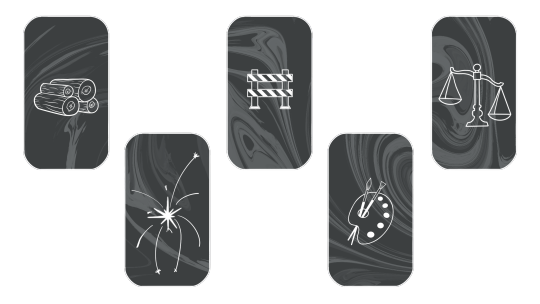
Runes:Fire runes, such as Fehu and Kenaz, represent prosperity, creative energy, and illumination. These runes can be incorporated into divination practices and ritualistic work to access the transformative power of fire and receive guidance on matters related to personal growth and manifestation.
Sabbats:Fire plays a prominent role in sabbats like Beltane and Litha (Midsummer), where it represents passion, fertility, and the culmination of the Sun's power. These celebrations honor the transformative qualities of fire, encouraging individuals to embrace their own inner fire and engage in rituals that foster growth, abundance, and personal transformation.
Symbols of Transformation, Passion, Creativity, Inspiration, Purification, Power, Action, Body and Health:
Fire is a potent symbol of transformation, representing the transformative journey from old to new, from darkness to light. It ignites passion, creativity, and inspiration, serving as a catalyst for positive change. Fire also symbolizes purification, purging what no longer serves, and empowering individuals to take decisive action towards personal growth, wellbeing, and the manifestation of their desires.
Associations with Leadership, Willpower, Strength, Motivation, Courage, Conflict, Energy, Enthusiasm, Transformation:
Fire embodies qualities associated with leadership, willpower, strength, motivation, courage, and conflict. It represents the dynamic force that propels individuals forward, igniting enthusiasm, and infusing situations with vibrant energy. Through its transformative power, fire facilitates personal growth, instills motivation, and empowers individuals to overcome obstacles in their path.
Note on Individual Variations in Correspondences
It is crucial to acknowledge that while correspondences for fire have been widely explored and established, there exist individual variations in these associations. The significance and personal resonance of specific correspondences may vary from person to person, influenced by cultural backgrounds, personal experiences, and spiritual beliefs. It is essential to embrace and honor these variations, allowing individuals to connect with the correspondences that align most authentically with their own spiritual practices and intentions. It is 100% okay to create your own correspondences. There is zero need to rigidly conform to preexisting ones unless working within a specific cultural context.

🔥Ways Fire is Commonly Used in Witchcraft🔥
Fire holds a significant role in the practice of witchcraft, serving as a potent and transformative tool for various rituals and magical workings. This section will explore several common applications of fire in witchcraft, highlighting their purpose and significance.
Candle Magic
Candle magic is one of the most prevalent and versatile practices within witchcraft. Candles serve as symbolic representations of fire, harnessing its energy and allowing practitioners to focus their intentions in order to manifest them. Through the selection of specific colors, shapes, and scents, practitioners align their intentions with corresponding qualities and elements, practitioners can build a threshold to project their spell through. While candle magic is simple and very approachable, It is essential to understand that in order for any working to truly be a spell it must include passion, intent (as in personal truth), and gnosis. Energy work must also be present, but for those who have not figured out how to do so consciously, it will happen subconsciously. In some cultures and traditions it is common practice to smother a candle’s flame rather than blow it out. This is because breath often is a physical representation of intent and fire often represents life, hope, and transformation.
Incense
Incense has been utilized for centuries in spiritual and magical practices across various cultures. It involves the burning of aromatic plant materials, releasing fragrant smoke that carries intention and purifies the space. The use of incense in witchcraft facilitates a connection between the material and spiritual realms, purifies the energy within a sacred space, and enhances the atmosphere during rituals and spellwork. Different types of incense, such as resin, herbs, or powdered blends, can be chosen based on their correspondences with specific intentions or desired outcomes. This works so well because the fire refracts and distributes the energetic properties of the plants and resins that make up the incense.
Bonfires
Bonfires hold deep-rooted symbolism and have been a staple in witchcraft and pagan traditions throughout history. They serve as a powerful focal point for community gatherings, celebrations, and transformative rituals. Bonfires embody the essence of fire's transformative energy, representing the burning away of the old and the welcoming of the new. The flames and embers provide a mesmerizing backdrop for ceremonies, invoking a sense of unity, passion, and connection with the primal forces of nature.
Fire Scrying
Fire scrying is a divination technique that utilizes the flames or smoke of a fire to gain insights and spiritual guidance. By gazing into the flames and allowing the mind to enter a trance state, practitioners can perceive symbols, images, and messages within the dance of the fire. The shifting shapes and patterns within the flames offer a canvas for intuitive interpretation, enabling practitioners to receive guidance and gain clarity on various aspects of their lives. Scrying can be a very difficult form of divination as it requires trance states and the ability to think figuratively and visually. Traditionally, scrying uses a candle that is gazed at through a reflective surface to the same end.
Burning Offerings
The act of burning offerings is a sacred practice found in many spiritual traditions, including witchcraft. Offerings, such as herbs, incense, written prayers, or symbolic objects, are intentionally burned as a means of communication and reverence towards deities, spirits, or ancestors. The rising smoke carries the essence of the offering, symbolically delivering it to the spiritual realm. This act of sacrifice and devotion fosters a connection with the divine, establishes reciprocity, and seeks blessings, protection, or guidance from higher powers.
Fire Rituals
Fire rituals encompass a diverse range of practices that incorporate fire as a central element. These rituals are designed to evoke transformation, empowerment, and spiritual growth. Examples include fire dances, where participants move rhythmically around a bonfire, embodying the transformative energy of fire within their bodies and spirits. Fire jumping rituals symbolize the release of negativity and obstacles, as individuals leap over flames, leaving behind what no longer serves them. Fire rituals serve as powerful catalysts for personal and collective transformation, inviting participants to embrace the element's purifying and empowering qualities. Like all other magical workings, rituals also require passion, intent, and gnosis. If working with a group, the intents of all practitioners must align.
Sigil Activation
In witchcraft, fire is utilized as a means to activate sigils, harnessing its transformative energy. This activation is achieved through the chemical and energetic transformation of the sigil, as the flames interact with the material medium. The heat energy of the fire alters the composition of the sigil, invoking a shift in its inherent properties. This process projects its energy into the environment, where it can bond with the ambient energies surrounding it.

🔥‼️Safety Tips for Working with Fire in Witchcraft‼️🔥
When incorporating fire into witchcraft practices, it is essential to prioritize safety to prevent accidents and ensure a controlled environment. This section outlines important safety tips that practitioners should consider when working with fire in their magical rituals and spellwork.
Fire Safety Equipment
Before engaging in any fire-related activities, it would be wise to have the appropriate fire safety equipment readily available. This includes items such as fire extinguishers, fire blankets, and heat-resistant gloves, or a lid to smother fires within cauldrons or other burning apparatuses. Fire extinguishers should be placed within reach and regularly inspected to ensure they are in proper working condition. In the event of an emergency, practitioners should familiarize themselves with the operation of fire extinguishers and have a clear evacuation plan. It is possible to construct your own fire extinguishers at home fairly cheap.
Method 1
Method 2
Clear Workspace
Maintaining a clear and clutter-free workspace is vital when working with fire. Remove any flammable materials or objects from the immediate vicinity to minimize the risk of accidental fires. This includes ensuring that curtains, papers, loose fabrics, and other combustible items are kept away from open flames or hot surfaces. By creating a clean and organized workspace, practitioners can reduce the chances of fire hazards and promote a safer environment.
Controlled Environment
When working with fire, it is advisable to choose a controlled environment. Perform rituals and spellwork in well-ventilated areas away from curtains and flammable objects, preferably outdoors or in spaces specifically designated for such activities. Avoid conducting fire-related practices in areas with strong drafts, as this can lead to unpredictable fire behavior. Additionally, be mindful of local regulations and any seasonal or weather-related restrictions that may affect the use of open flames. It is not recommended to perform fire magic inside of a trailer home, as they catch fire and burn down very easily and quickly. If you are using fire indoors, be sure to leave any doors or escape windows open.
Candles and Incense
When using candles and incense, it is essential to exercise caution and adhere to proper safety practices. Ensure that candles are placed on heat-resistant surfaces and in stable holders to prevent them from toppling over. Avoid positioning candles near flammable materials, low-hanging decorations, or areas with a high risk of accidental contact. Use candle snuffers or a gentle blowing technique to extinguish candles, as blowing can potentially spread hot wax or embers. Similarly, when burning incense, do so in appropriate holders that can contain ash and prevent accidental fires. Place incense burners on heat-resistant surfaces and away from flammable materials. Always extinguish incense sticks or cones fully before leaving the area unattended.
Clothing
Practitioners should carefully consider their clothing choices when working with fire. Loose, flowing fabrics can pose a fire hazard, especially when in close proximity to open flames. Opt for well-fitting, natural fiber garments that are less likely to catch fire or melt. Long sleeves should be rolled up or secured to prevent them from coming into contact with flames or hot surfaces. Additionally, avoid wearing accessories or jewelry that could potentially catch fire or interfere with safe fire handling.
Fire Proofing
When burning anything in witchcraft, especially in metal containers or windy conditions, it is essential to fire proof your work space. This can be done by placing a stone or tile underneath your container. If working in windy or drafty conditions, be sure to find an area that is devoid of dried plant materials and burn on top of dirt or stones. If at all possible, dig a hole to burn in and surround it with stones. This will help prevent the fire from spreading into the environment.
Ritual Preparation
Thorough ritual preparation is essential for working with fire safely. This includes planning the sequence of actions, ensuring all necessary materials are readily accessible, and familiarizing oneself with the ritual steps beforehand. Practitioners should consider the timing, duration, and specific fire-related elements of the ritual to anticipate any potential risks or challenges. By adequately preparing for rituals, practitioners can approach fire-based practices with confidence and reduce the likelihood of accidents.
Personal Protection
Personal protection should be prioritized when working with fire. This includes wearing heat-resistant gloves when handling hot objects, using appropriate tools for fire handling, and taking necessary precautions to protect the face and body from heat and sparks. Depending on the nature of the ritual or spellwork, practitioners may also consider wearing protective eyewear and clothing. If the fire you're working with is small, be sure to use a pot-holder to handle containers in order to prevent burning yourself.
Education and Training
To ensure safety when working with fire, it is strongly recommended that practitioners seek proper education and training. Learning from experienced practitioners or attending workshops and classes dedicated to fire safety and fire-based practices can provide valuable knowledge and skills. Gaining a comprehensive understanding of fire behavior, safety protocols, and emergency response techniques is essential for minimizing risks and handling fire-related situations effectively.
Here is a guide on putting our fires without an extinguisher.
If a fire becomes out of control, please evacuate as soon as possible and call 911. Stay low to the ground and avoid opening any doors or windows as that will cause the fire to grow rapidly and increase the possibility of getting burned.

🔥Misconceptions about Using Fire in Witchcraft🔥
Fire has long been a powerful symbol in various mystical and spiritual practices, including witchcraft. However, there are several misconceptions surrounding the use of fire in these contexts. This section aims to address and debunk some of the common misconceptions associated with fire in witchcraft.
Fire Is Associated with Negative or "Evil" Practices
One prevailing misconception is that fire in witchcraft is exclusively linked to negative or "evil" practices. Rooted in the idea of the duality of Sanctity and Profane, this notion stems from historical and cultural biases that have demonized certain aspects of witchcraft and associated them with dark or malevolent forces. However, fire, like any element, is neutral in nature and can be employed for both positive and negative intentions. In witchcraft, fire is often harnessed as a transformative force, symbolizing purification, passion, creativity, and empowerment. It is essential to understand that the intentions and ethics of the practitioner shape the outcome of their fire-related practices, rather than the element itself being inherently evil. White supremacy played a significant role in shaping the perception of witchcraft and its association with fire. Racial stereotypes and prejudices were deeply ingrained in colonial societies, and people of African descent were often portrayed as inherently "primitive," "savage," and associated with "dark" and "dangerous" forces. These racial biases contributed to the stigmatization of fire in African spiritual traditions, which were wrongly labeled as demonic and inherently evil.
Fire Magic Is Always Dangerous
Another misconception is that fire magic is always dangerous. While it is true that working with fire demands caution and respect, it does not mean that fire magic is inherently unsafe or prone to accidents. With proper safety measures, knowledge, and experience, practitioners can minimize risks and ensure a controlled environment when working with fire. Adhering to safety tips such as using appropriate fire safety equipment, creating a clear workspace, and practicing in controlled environments significantly mitigates potential dangers. It is crucial for practitioners to approach fire magic with responsibility, preparedness, and a deep understanding of the element's behavior and properties. It is very possible to perform fire magic without the need to directly burn something, as all that is needed is a combustion reaction which happens in every single cell in our bodies.
Fire Magic Is Only for Experienced Practitioners
There is a misconception that fire magic should be reserved exclusively for experienced practitioners. While it is true that a certain level of knowledge and experience can enhance one's ability to work with fire effectively, it does not mean that beginners or less experienced individuals cannot incorporate fire into their practices. With proper education, mindfulness, and respect, practitioners at all levels can explore and engage with fire magic safely and responsibly. It is recommended that newcomers to fire magic start with simple practices, gradually increasing their skills and understanding as they gain experience. Communicating with other practitioners can provide valuable guidance and support in developing fire-related working.
Fire Magic Is Always Dramatic or Flashy
Many people have the misconception that fire magic is always dramatic or flashy, involving large bonfires, roaring flames, and extravagant displays. This is largely influenced by media such as movies, video games, and TTRPGs. While such practices may potentially exist- not including things such as Fireball of course, it is important to note that fire magic can encompass a wide range of approaches and intensities. Fire magic can be as subtle as working with small candles, utilizing controlled flames, or employing symbolic representations of fire. The effectiveness of fire magic lies not in its outward grandeur, but rather in the focused intention, energy, passion, and correspondence that the practitioner brings to their practice. It is the internal connection and alignment with the elemental energy of fire that truly matters, rather than the external showmanship.

🔥Properties of Fire🔥
To gain a comprehensive understanding of fire in the context of witchcraft, it is essential to explore its properties across various categories. These categories include energetic properties, physical properties, philosophical properties, and chemical properties.
Energetic Properties of Fire
From an energetic standpoint, fire has four inherent properties:
Thermal: It radiates energy outwardly in various directions.
Reactive: It is chaotic and bonds with the surrounding environmental energies very easily without outside influence.
Isentropic: Can change its energetic state without the loss of any energy within the system, but will always resort back to its original state.
Refractive: Breaks down the energies of its fuel and can take on their properties.
Thermodynamics, a branch of physics concerned with the interplay of energy and heat transfer, offers insights into the energetic properties of fire. One fundamental concept in thermodynamics is entropy, which measures the level of disorder or randomness in a system. When fire occurs, the combustion process leads to an increase in entropy as the fuel source breaks down and transforms into gases, releasing heat and light in the process. This increase in entropy is representative of the transformative nature of fire, as it breaks down and reorganizes matter, symbolizing the transition from one state to another. By understanding the principles of thermodynamics and entropy, practitioners can appreciate the profound energetic transformations that occur within fire-related practices.
Physical Properties of Fire
On a physical level, fire is characterized by heat, light, and combustion. It is the visible result of the exothermic chemical reaction between a fuel source and oxygen, resulting in the release of heat and light energy. Fire's physical properties, such as its ability to consume, transform, and illuminate, make it a potent symbol of change and illumination within witchcraft. The physical properties of fire are often utilized in rituals, spellwork, and divination practices to symbolize purification, enlightenment, and the manifestation of desires.
Philosophical Properties of Fire
Philosophically, fire is associated with concepts such as willpower, passion, courage, and personal transformation. Fire's ability to consume and purify represents the process of burning away the old, making space for the new, and undergoing personal metamorphosis. It is often viewed as a catalyst for change and a symbol of the human spirit's resilience and inner strength. The philosophical properties of fire in witchcraft inspire practitioners to embrace their inner power, overcome obstacles, and pursue their desires with unwavering determination. Metaphysically, fire is associated with various esoteric and occult traditions. It is believed to embody the spiritual essence and its transformative qualities on a metaphysical level. Fire is often associated with the will, passion, and the spiritual spark within each individual. It is seen as a force that can illuminate the path of spiritual growth, aid in the manifestation of desires, and facilitate the connection between the physical and spiritual realms.
Chemical Properties of Fire
On a chemical level, fire involves complex reactions known as combustion, which occur when a fuel source reacts with oxygen in the presence of heat. These reactions are fundamentally redox (reduction-oxidation) reactions, involving the transfer of electrons from the fuel to the oxygen.
During combustion, the fuel undergoes oxidation, releasing energy in the form of heat and light. The process can be represented by a generalized equation:
Fuel + Oxygen → Carbon Dioxide + Water + Energy
The fuel can be organic materials such as wood, paper, or natural fibers, or even hydrocarbons like methane or propane. Oxygen, usually obtained from the surrounding air, acts as the oxidizing agent. As the fuel combines with oxygen, chemical bonds break and reform to produce new compounds.
The combustion reaction releases energy due to the difference in energy between the reactants (fuel and oxygen) and the products (carbon dioxide, water, and other byproducts). This energy, in the form of heat and light, is what we perceive as fire.
The intensity and behavior of fire can be influenced by several factors, including the nature of the fuel, the availability of oxygen, and the heat supplied to initiate and sustain the reaction. These factors impact the rate at which the combustion reaction occurs, affecting the size of the flame, the heat output, and the color of the fire.
Classic Alchemical Properties of Fire
Calcination: The Role of Fire in Reduction
Calcination, one of the primary laboratory processes in alchemy, involved subjecting matter to intense heat in a crucible. This process aimed to reduce the material to its essential components, burning away impurities and leaving behind a residue or ash.
Distillation: Vaporization and Condensation
Through the process of distillation, alchemists harnessed the power of fire to induce the vaporization of substances. The resulting vapors were then condensed and collected, facilitating the separation and purification of the desired elements.
Sublimation: Transformation by Controlled Heating
Sublimation involved the controlled heating of solid matter to induce a direct transition from solid to vapor without passing through the liquid state. Alchemists recognized the transformative potential of fire in this process, as it allowed the extraction of volatile and ethereal substances from solid materials.
Historical Accounts and Examples
Historical accounts and alchemical treatises provide insight into the practical application of fire in laboratory processes. These include the experiments conducted by renowned alchemists like Paracelsus and Ramon Llull, who meticulously documented their observations and discoveries.

🔥Burning Sigils in Magic🔥
Sigils hold a significant place in magical practices, and their utilization in witchcraft has been prevalent for centuries. Understanding the concept of sigils, their activation, and the practice of burning them can provide insight into their role as a powerful tool in magical endeavors.
Definition of Sigils
Sigils can be described as symbols or graphical representations that encapsulate specific intentions, desires, or manifestations. These symbols are created by combining various shapes, letters, or symbols into a unique and meaningful design. The process of creating a sigil involves condensing the desired outcome into a visual representation that serves as a focal point for the practitioner's intent.
Activation of Intentions through Burning Sigils
Burning sigils is a common method used to activate the intentions encoded within them. When a sigil is burned, it is believed that the energy released during the combustion process acts as a catalyst, propelling the intended outcome into the spiritual or metaphysical realms. The act of burning the sigil serves as a transformative ritual, symbolizing the release and transmutation of the practitioner's intentions into the universe. This process works due to the inherent energetic properties of fire. As the sigil burns, the energies involved are refracted and released.
Sympathetic Magic and Connection to the Spiritual Realm
The practice of burning sigils can be seen as an expression of sympathetic magic, a concept rooted in the idea that like produces like. By burning the sigil, practitioners establish a connection between the physical act and the desired outcome in the spiritual realm. This connection is believed to create a resonance between the symbol and the intended manifestation, facilitating the alignment of energies and increasing the likelihood of the desired outcome. That being said, without guidance the energies released will travel radially in all directions. The sigil will be aimless and short lived. However, with conscious energy work a practitioner may capture the energy and direct it to exactly where it is desired to travel. This can be accomplished through taglocks or astral projection.
Methods of Burning Sigils
Various methods can be employed when it comes to burning sigils, allowing practitioners to personalize their approach based on their preferences and the specific magical working at hand. Some common methods include:
Burning in a Ritual Fire: This method involves placing the sigil in a consecrated fire, such as a ritual bonfire or a consecrated fireplace, while invoking the intended outcome. The sigil is consumed by the flames, symbolizing the release of the intention into the universe.
Candle Flame Burning: Here, the sigil is placed in the flame of a candle, allowing it to burn gradually. The practitioner may choose a specific color of candle that aligns with the intention of the sigil, further enhancing the magical working.
Charcoal Burning: Using a charcoal disc, the sigil can be burned by placing it on top of the lit charcoal. As the charcoal burns, it generates heat, causing the sigil to ignite and release the encoded intentions.
Paper Burning: This method involves writing the sigil on a piece of paper and then safely burning it. The ashes can be collected and either scattered in a sacred space or buried, symbolizing the integration of the intention into the earth.
By employing these methods, practitioners engage in a transformative act that merges physical symbolism with metaphysical intent, providing a tangible and intentional approach to magical workings.
Alternatives to Burning Sigils
Shredding: Instead of burning the sigil, you can safely shred it into small pieces. This can be done manually or by using a shredder. The act of physically tearing the sigil can serve as a symbolic release of the intention. Energetically, it can rend the energies from the sigil so that the practitioner may control its direction.
Dissolving: Place the sigil in a bowl of water or any other appropriate liquid. As the paper dissolves, the intention is gradually released into the water. From there, the energies can be handled and sent to their desired location. You can then dispose of the liquid in a respectful manner, such as pouring it onto the earth or down the drain.
Burying: Dig a small hole in the ground and bury the sigil. As you cover the sigil with soil, so the energy of your intention merges with the earth, where it can grow over time.

🔥Effects of Temperature on Spirits in Spirit Work🔥
Within the realm of spirit work, practitioners often experience various sensations associated with the presence of spiritual entities. Temperature fluctuations are among the commonly reported effects that can be observed during spiritual encounters. Understanding these temperature-related experiences can deepen our comprehension of spirit work and its intricate dynamics.
Sensing Presence
One of the possible ways through which spirits manifest their presence is by influencing the temperature in their surroundings. Practitioners may perceive sudden and unexplained changes in temperature, which can range from localized coolness to areas of noticeable warmth. These temperature shifts often coincide with the presence of a spirit, acting as a potential indicator of their energetic presence.
Heat or Warmth
In contrast to the chilling effect, some practitioners may encounter instances of increased heat or warmth in the presence of spirits. This warming sensation is believed to arise from the heightened energy emitted by the spirit. It is worth noting that the perception of heat or warmth may not necessarily be related to the ambient temperature but rather a distinct sensation experienced by the practitioner. In some traditions, heat is thought to excite spirits and can become dangerous, especially when channeling.
Symbolic Significance
Temperature fluctuations during spirit work also carry symbolic significance within various cultural and belief systems. For instance, coldness may be associated with the presence of spirits from the realm of the deceased, while warmth might be linked to benevolent or protective entities. These symbolic associations can provide practitioners with contextual information, aiding their interpretation of the spiritual encounter. It is important to note that individual experiences with temperature during spirit work can vary significantly. Factors such as personal sensitivity, psychic abilities, and cultural background can influence how practitioners perceive and interpret these temperature-related sensations. Therefore, it is essential for practitioners to acknowledge their own perceptual lens and approach spirit work with an open and discerning mindset.
Environmental Factors
While temperature fluctuations in spirit work are commonly associated with the presence of spirits, it is crucial to consider potential environmental factors that may contribute to such experiences. Natural drafts, air conditioning, or heating systems can influence the ambient temperature and create misleading perceptions. By ruling out mundane causes, practitioners can strengthen their discernment of genuine spiritual interactions.
Validation through Consistency
The consistency and repetition of temperature-related experiences can add weight to their significance in spirit work. When practitioners consistently observe temperature fluctuations in conjunction with other spiritual phenomena, it enhances their confidence in the validity and relevance of these encounters. Corroborating experiences from multiple practitioners can also provide a broader perspective and further validate the observed temperature effects.
Personal Beliefs and Cultural Perspectives
Lastly, personal beliefs and cultural perspectives play a vital role in shaping practitioners' understanding of temperature fluctuations in spirit work. Different belief systems may attribute diverse meanings to these experiences, reflecting the rich diversity of spiritual traditions worldwide. Remaining open to multiple interpretations fosters a more inclusive and comprehensive approach to understanding the effects of temperature in spiritual encounters. By exploring and analyzing the effects of temperature on spirits in spirit work, practitioners can deepen their awareness of these phenomena, refine their discernment, and develop a nuanced understanding of the dynamic interactions between the physical and spiritual realms.

🔥Elemental Fire in Hermetic Alchemy🔥
While I personally do not recommend the practice of Hermeticism due to its connection to new age conspiracy theories, New Thought, the Theosophy Society, and a tendency to rely on dualities, especially when concerning gender, it can be a helpful reference for building correspondences and inspiration for spell design.
Hermeticism, originating from the teachings attributed to Hermes Trismegistus, a character without any record of ever existing, encompasses a vast body of knowledge that includes alchemy, astrology, and spiritual philosophy. At its core, hermeticism emphasizes the pursuit of inner wisdom, the unity of all things, and the transformative power of the divine. Within hermetic philosophy, the concept of the Prima Materia, the primal and formless substance from which all creation arises, holds great importance. In hermetic thought, the Prima Materia is often associated with fire, symbolizing its energetic and transformative qualities.
In hermetic practices, fire is often incorporated ritualistically and symbolically. Ceremonial rituals involving candles, incense, and sacred flames serve as potent symbols of spiritual purification, transformation, and the invocation of divine energies. Historical figures like Hermes Trismegistus and Paracelsus made significant contributions to the exploration of fire in hermeticism. Hermes Trismegistus spoke of the "Living Fire," representing the divine spark within every being and the potential for enlightenment. Paracelsus, a renowned Renaissance alchemist, explored the nature of elemental fire and its transformative properties, shedding light on the alchemical processes involving fire, such as calcination, distillation, and sublimation.
Modern hermeticism, with its revival in esoteric circles, continues to inspire seekers of wisdom and truth. It offers practical applications of fire as a transformative agent in rituals, ceremonies, and meditative practices. Contemporary hermetic traditions emphasize the cultivation of the inner flame and willpower, harnessing the transformative power of fire for personal growth and manifestation. Fire is interpreted as a metaphor for personal growth and enlightenment, consuming and transforming limiting beliefs to ignite the spark of self-realization.

Interested in my other articles? You can find my masterpost here.
Patron Shoutouts!
Megan Kipp
Jinsu
Ing Mar
Cosmicaquamarie
Thank you for your continued support! My patrons help me maintain the drive to create content and help me keep food in my pantry.

My patrons of Mystic tier and higher had access to this article at least a week before it was public! To see other perks of supporting me, click here!
#witchcraft#Classical elements#beginner witch#correspondences#fire witch#witchcraft guide#witchcraft resource#informational post
100 notes
·
View notes
Text
A while back I made a series of posts examining the real-world origins of every fish Pokémon. It’s been a while but I’ve gotten the urge to do more of that. So now I’m doing the same thing, but with every aquatic non-fish Pokémon instead. What I define as aquatic is that it has been depicted as aquatic either in Pokédex entries or in the main series games. Most of them are water-types but not all and there are even a few water types I don’t think are aquatic. I’m also going to cover the water starters and legendaries/mythicals in their own segments. I will start with generation I, which I will be splitting in half because of how many there are. This entry will cover the Psyduck through Shellder lines while part 2 will cover the Krabby through Dratini lines.
The Psyduck line seems pretty obvious. It’s right in the name, they’re ducks, right? Well I’m not entirely convinced that’s all. Psyduck has the classic yellow duckling/rubber duck coloration, but it clearly has arms instead of wings. There’s another hint of them not being ducks in their typing. Back in the development of gen I, the flying type was called the bird type. This is why the Doduo line is part flying despite being flightless. The similarly flightless psyduck line not being granted the bird type makes me think they aren’t supposed to be ducks, but rather playtpuses (platypi?). These are among the only surviving monotremes, a lineage of primitive, egg-laying mammals that may represent a stage of development between pre-mammal therapsids and modern viviparous mammals. The platypus has four legs with webbed toes and a duck-like bill, just like the Psyduck line. The only thing the two are missing is the beaver-like tail.
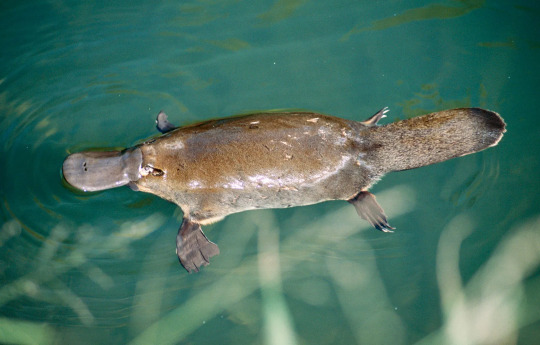
(image: a chimera platypus)
Golduck is also based on the kappa, a creature of Japanese folklore described as a humanoid with a beak that lurks in ponds and streams. The gem on Golduck’s forehead is likely based on the third eye symbolism you get in a lot of new-age woo and the pseudoscience of parapsychology, which was adapted from the chakras of Hinduism. This is in reference to the line having psychic powers despite not being psychic-type.
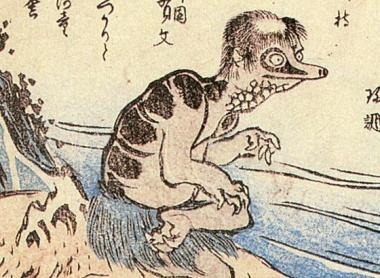
(image: one of many depictions of a kappa)
The Poliwag line are based on tadpoles, the larval stage of frogs. As they mature, tadpoles go from basically a head with a tail on it to a tailless frog. Poliwag represents an early stage in the metamorphosis of a tadpole where it starts to grow hind legs and has not yet lost its tail or started to grow its front legs.

(image: a tadpole with its hind legs grown in)
Poliwhirl and Poliwrath are a more advanced state of metamorphosis where the tadpole has grown all its legs and lost its tail, but is still not a mature frog. Only if Poliwhirl evolves to Politoed does it become a mature frog. Poliwrath never fully maturing is an example of neoteny, a species retaining juvenile traits into adulthood. There aren’t any examples of neotenic frogs that I could find, but there are neotenic salamanders, most famously the axolotl, with keeps multiple juvenile traits as an adult. Politoed is just a generic green frog. The spirals on the bellies of the line is a reference to how some species of frog have such thin abdominal skin in their tadpole stage that their intestines can be seen through the skin. (warning, potentially gross picture below).

(image: a tadpole with visible intestines)
The tentacool line are jellyfish. Specifically, Tentacool may be a box jellyfish, the only jellyfish with true eyes.
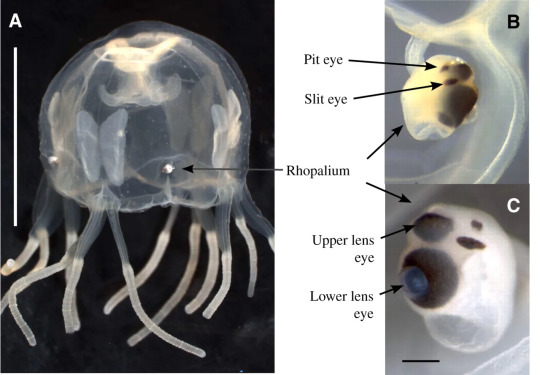
(image: diagram of a box jellyfish with focus in the eyes. source)
Several species of box jellyfish are also extremely dangerous to humans, with their venom causing extreme pain and death. Tentacruel may also be based on the Portugese man-o-war (in fact, Manowar was its prototype English name). Despite looking similar and having a similar hunting style, man-o-wars are not jellyfish, but siphonophores, an extremely cool group of colonial cnidarians you can learn about here. Man-o-wars float on the surface of the water and with for prey to run into their stinging tentacles. Tentacruel is often depicted hunting in a similar style.

(image: a man-o-war)
Finally, the line’s big red gems and ability to fire laser beams from them likely comes from “bug-eyed monsters” a classic type of sci-fi monster typically found in b-movies.
The Slowpoke line are weird. They are one of those Gen I lines that are weird monsters with little in the way of real-life counterparts like the Nidos, Rhyhorn, and Kangaskhan. I think Slowpoke is a combination of hippos and giant salamanders. It has the little round ears and snout of hippos (which spend much of their time in the water) while its body shape and behavior are closer to giant salamanders. Not just any big salamanders though, they are based on the Cryptobranchids, of which there are three living species: the Chinese giant salamander (actually 5 closely-related species), Japanese giant salamander, and north American hellbender. These giant salamanders spend most if not all their time underwater and are known to be very long-lived and spend most of their time sitting perfectly still, waiting for prey to pass by. Their very still and slow lifestyles inspired Slowpoke’s slowness and stupidity.
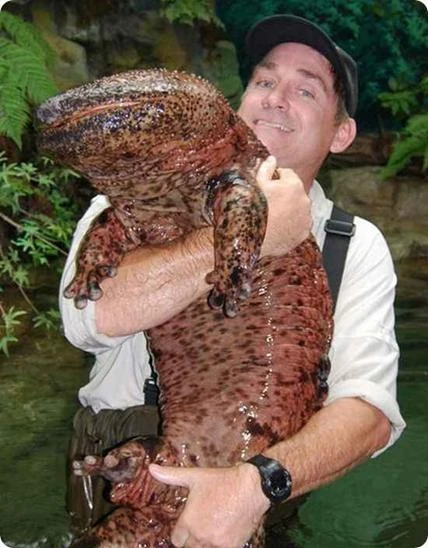
(image: a man holding a giant salamander and fulfilling a wish I didn't know I had until just now)
Things get more complicated when Slowpoke evolves. Both Slowbro and Slowking have a symbiotic relationship with a shellder that bites onto their tail or head, respectively. The shape of the Shellder is based on a turban snail and was planned to be available as an evolution foe Shellder in the Gold/Silver beta called Turban. The fact that the line’s Japanese names (Yadon, Yadoran, and Yadoking) come from the word “yadokari” meaning “hermit crab” and Slowbro being called the hermit crab Pokémon is pretty clear that they supposed to be hermit crabs despite being possibly the least hermit crab-like creatures ever. Come to thing of it, Digimon has Shellmon, another supposed hermit crab that's a weird pink monster sticking out of a turban snail shell. I don't know what to make of that. The hermoit crab connection isn't a very strong connection as hermit crabs live in the discarded shells of snails for defense while only mega Slowbro can actually withdraw into the Shellder. Slowking’s Shellder being on its head and it having that neck ruff is a reference to royalty wearing ruffs, crowns, and turbans. It being the smartest of the Slows may also draw from imagery of the wise, middle-eastern vizier or scholar trope. Finally, both evolutions are based on the sazae-oni, a legendary Japanese sea monster that wears a turban-shaped snail shell. The Pokémon version did not keep the part of the legend where it steals a bunch of sailors' testicles and holds them for ransom.
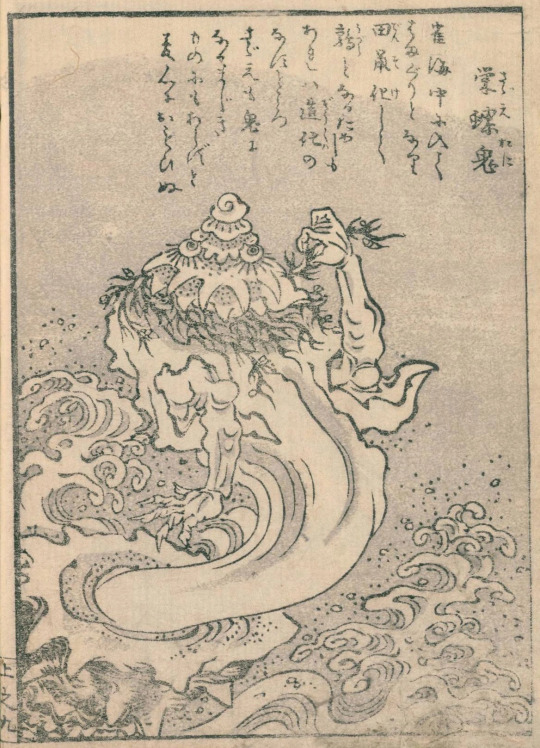
(image: a depiction of the sazae-oni)
The Galarian forms aren’t much different, though they seems to have moved to a more terrestrial lifestyle. Their Shellders being poison-type may reference the highly toxic cone snails. Galarian Slowbros Shellder being on its arm and acting as a projectile weapon references side arms and arm cannons while Galarian Slowking is a more sinister take on the turban-wearing wise man, with its Shellder now looking like a pointy witch hat.
Seel is, rather obviously, a seal, probably a harp seal pup. In addition to its seal origin, it may have some inspiration from other arctic marine mammals: the “horn” of a narwhal, white color of a beluga, and tusks of a walrus. Dewgong is named after the dugong, a relative of the manatee, but that is where their similarities end. Dugongs are rotund sirenians while Dewgong is obviously a seal. It’s a more mature Seel, with all the same inspirations.
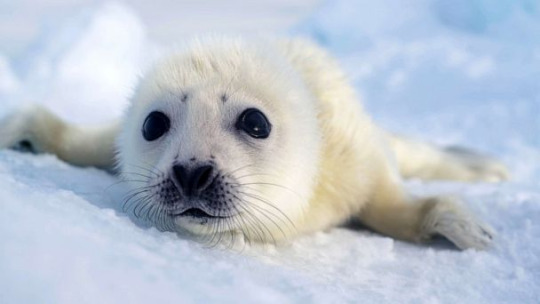
(image: a harp seal pup, easily the cutest thing I've ever put on this blog)
Shellder and Cloyster are both a hodgepodge of various bivalves. Shellder is a combination of clam and scallop. Clams spend most of their time buried under sand and have a powerful foot that can stick out of the shell and is used for moving and digging. Clams also have siphons, organs that are used to intake water, that can be extremely large in some species, most notably the geoduck.

I know what you're thinking and shame on you (Image: a geoduck clam)
Shellder’s constantly exposed tongue is likely a representation of the foot or siphon. They are also based on Scallops, which can swim short distances by rapidly opening and closing their shells to shoot out water.

And now you know why Spongebob made these into birds (gif: a scallop swimming)
Cloyster retains the Scallop swimming methods, but are more based on thorny oysters and true oysters. Thorny oysters are known for having prominent spines on their shells to deter predators.

I CAN FEEL THE WARP OVERTAKING ME! (image: a thorny oyster)
True oysters are the most famous pearl-producing bivalves. Cloyster’s head is based on a pearl, specifically a black pearl. These are produced by only a few species and are very valuable due to their rarity.

(image: black pearls on the shell of one of the species that make them)
That’s it for the first half of gen I. I will return soon (hopefully tomorrow) for the second part and they we will move on to gen II and beyond.
91 notes
·
View notes
Text
This is the second poll in the series im going to be doing
(please do not vote on this if you are not alterhuman)
please reblog if you vote for a bigger sample size!
poll one (mammals): 🐈
poll two (reptiles/amphibians): 🦎 (you are here)
poll three (avians): 🦜
poll four (invertebrates) : 🐛
poll five (aquatic creatures): 🐟
#poll#survey#alterhuman#alterhuman community#alterhumanity#otherkin#otherkinity#otherkin community#kintype#theriotype#therian#theriomythic#therianthropy
39 notes
·
View notes